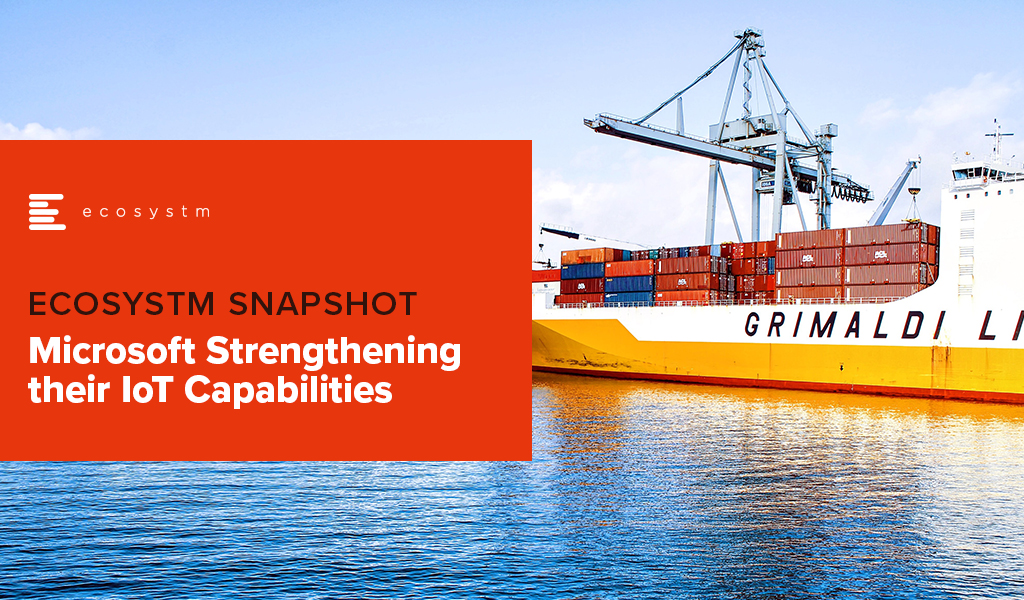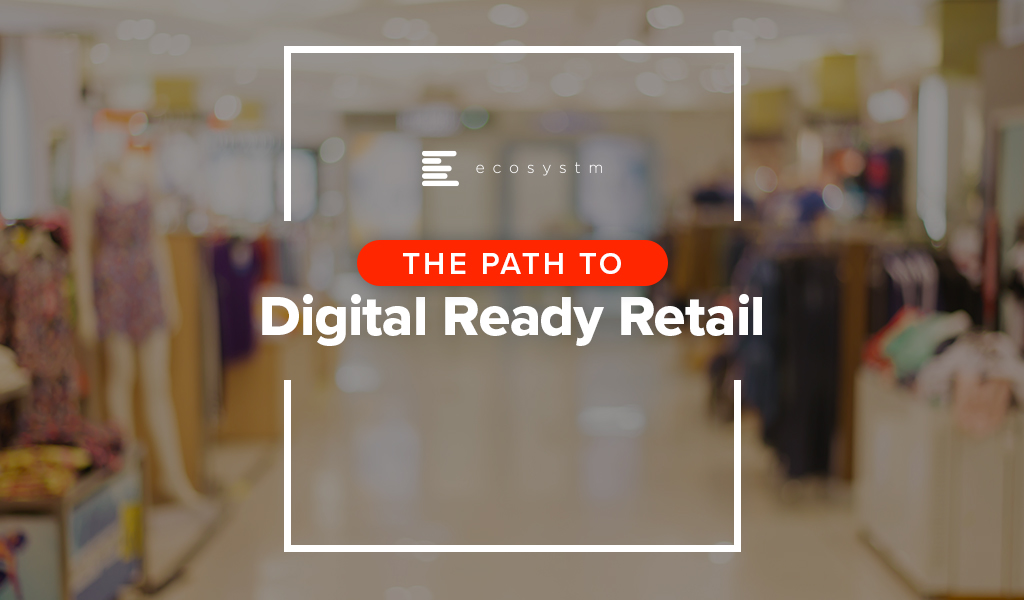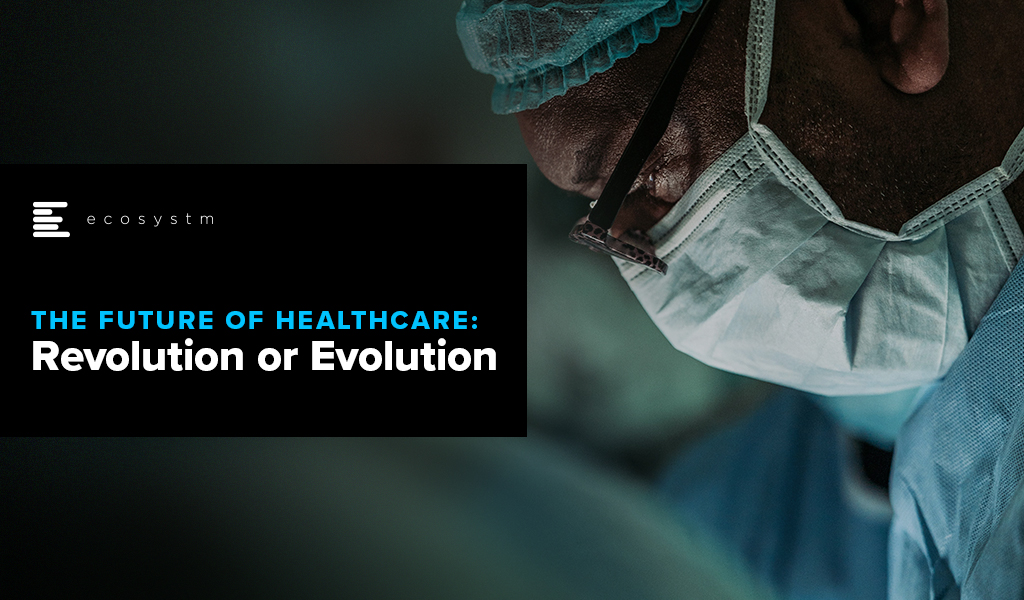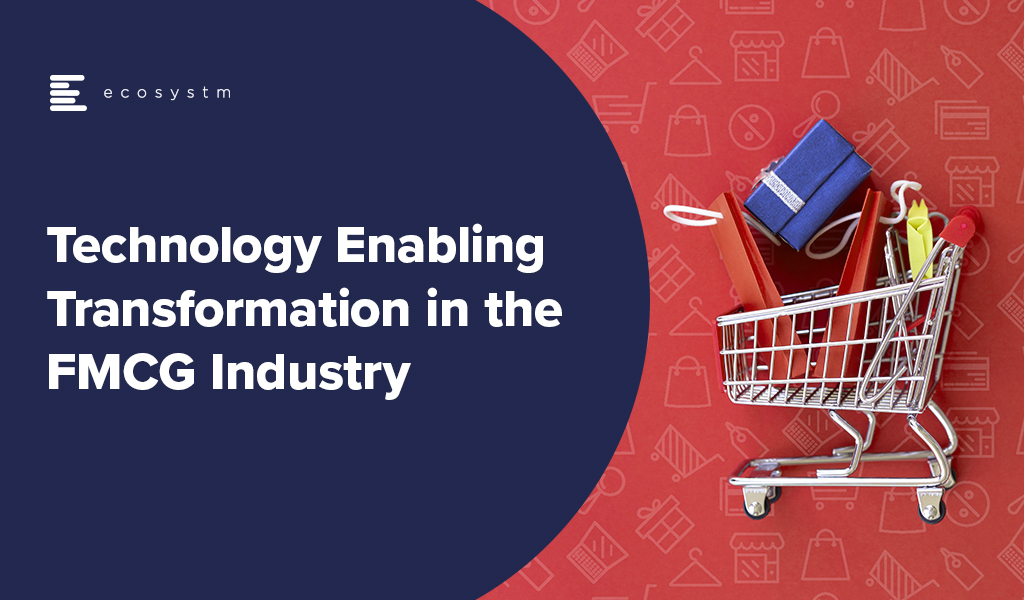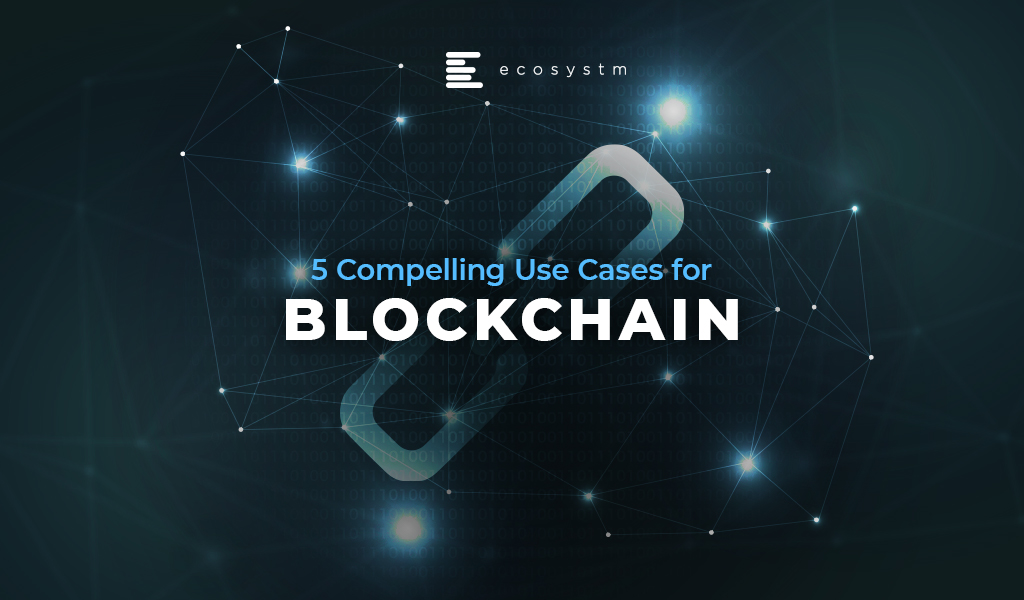Microsoft announced in 2018 that they were investing US$ 5 billion globally in IoT innovation and research for the next 4 years – the focus being on secure IoT, creating development tools and intelligent services for IoT and the edge, and on growing their partner ecosystem.
Last year Microsoft’s industry updates showcased several IoT implementations across industries and their edge-based solutions portfolio, customers and partner ecosystem. The tech giant revealed nearly 150% YoY growth with customers such as Starbucks, Chevron, Walmart, Walgreens, BMW and Volkswagen added to the Azure platform, leveraging IoT services to accelerate their digital transformation journey. Microsoft also announced more than 70 partnerships with some of the big names in the IoT ecosystem, such as Universal Electronics, SAP, and Cradlepoint to extend solutions and support for the Microsoft IoT business.
Extending IoT Capabilities with Strategic Partnerships
There were several recent announcements which indicate that Microsoft is focused on strengthening their IoT and industry capabilities – and this is a timely move. Ecosystm Principal Advisor, Kaushik Ghatak says, “COVID-19 has brought to the fore the need for managing risks better. And the key to managing risks is to have better visibility and drive data-driven decisions; the sweet spot for IoT technologies. IoT is at the core of the Industry 4.0 story where deep domain expertise in industry verticals is a pre-requisite to success. It is heartening to see that Microsoft is taking the lead in building a powerful ecosystem by developing key partnerships with leading providers of Industry solutions.”
Last week, Microsoft and Hitachi announced a strategic alliance to accelerate the digital transformation of the Manufacturing and Logistics industries across Southeast Asia, Japan and North America. The first solutions are expected to be made available in Thailand as early as this month. Hitachi brings to the table their industry solutions, such as Lumada, and their IoT-ready industrial controllers HX Series. These solutions will be fully integrated with the Microsoft cloud platform, leveraging Azure, Dynamics 365 and Microsoft 365.
The three areas where the Hitachi solution is expected to bring strength to Microsoft’s industry offering are:
- Process optimisation and increased manufacturing productivity. Hitachi Digital Supply Chain and Azure IoT leveraged to analyse 4M data collected from manufacturing sites for visualisation/ analysis of production processes
- Logistics optimisation. Digital technologies such as Azure Maps and Hitachi Digital Solution for Logistics/Delivery Optimisation Service to analyse data on parameters such as traffic congestion, storage locations and delivery locations, to enabling smart routing
- Predictive maintenance and remote assist. HoloLens 2, Dynamics 365 Remote Assist and other smart devices, to empower first-line workers
Ecosystm Principal Advisor, Niloy Mukherjee feels that with projections of 43 – 100 billion IoT connected devices in the next few years, IoT is obviously a hot space. “We can think of IoT as a stack with four layers – the devices/sensors, the connection layer, the cloud and computing layer and the business apps layer. With Azure, Microsoft is very well positioned in the cloud and compute layer and can grab a large chunk of this fast-growing market. Tying with players like Hitachi allows Microsoft to integrate with the business apps layer and perhaps also some devices. It is absolutely the right strategy and I would expect them to go for many more such alliances. With Microsoft’s strength in the enterprise market, IoT gives them a great opportunity to increase their share of cloud workloads with customers.”
Addressing the Challenges of IoT Adoption
Ecosystm research shows that the biggest challenges in IoT adoption are security and integration concerns (Figure 1).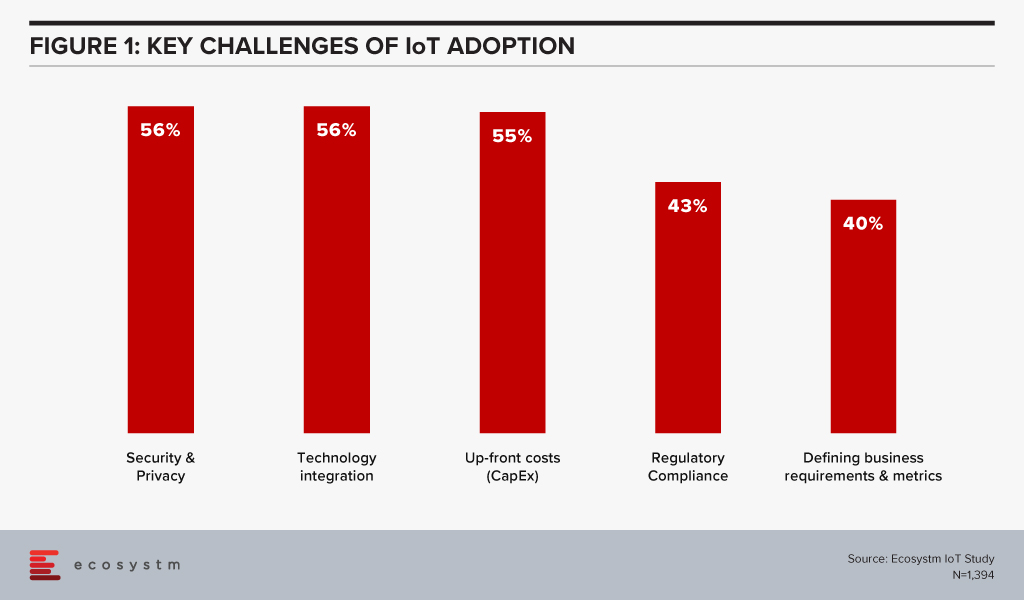
In 2018, when Microsoft started actively focusing on IoT, they also launched the Azure Certified for IoT program to maintain consistency and enhanced interoperability across their device partner ecosystem. This addresses the integration challenges that organisations face when deploying IoT. Microsoft continues to grow their IoT ecosystem, ensuring faster IoT deployments, with hardware and software that has been pre-tested and verified to work with Microsoft Azure IoT services. Last week also saw Cyient joining Microsoft Azure as a certified partner for IoT. Cyient IoT Edge Gateway 5400, their flagship IoT gateway product is now Microsoft Azure Certified for IoT. This is expected to accelerate IoT deployment for Cyient customers and enable a seamless integration of edge devices to the cloud.
Ghatak says, “To scale up their IoT business, Microsoft would need to develop a substantially large ecosystem, beyond few key players such as Hitachi, who dominate at the large enterprise segment of the market. That is where partnerships with smaller and niche industry solutions providers such as Cyient fits in. More niche providers such as Cyient will increase Microsoft’s reach into medium and smaller segments of the enterprise market.”
Addressing the Increasing Threat Landscape
Recent cyber-attack trends and security breach statistics reveal a huge increase in cybercrime activities, in the wake of the COVID-19 pandemic. As the number of IoT sensors, devices and gateways increase, so does the risk of security breaches. As shown in figure 1, cybersecurity concerns are real and can act as a barrier to IoT adoption, despite the benefits that the technology brings. Automated vulnerability management capabilities, that allow risk assessment and patch installation where necessary will see an increase in IoT adoption.
To complement Microsoft Azure IoT security, Microsoft acquired IoT security specialist CyberX, last month. The acquisition will enable greater security for the IoT devices connected to the Microsoft network and will help their customers to gain visibility through a map of devices thus allowing them to gather information on security risks associated with thousands of sensors and connected devices. This will enhance smart grid, smart manufacturing and digital assets and profiles and reduce vulnerabilities across production and supply chain.
Mukherjee says, “The key concern for the expansion of IoT into more and more use cases in the next few years is really going to be security. New areas like VR and AR are emerging from futuristic fantasy to real-world reality. These will tempt many enterprises – but security will be the key concern to address. And so, Microsoft’s simultaneous push on security completely aligns with this. As the Ecosystm MSSP VendorScope results show Microsoft’s strategy on cybersecurity seems to be working.”
Talking about Microsoft’s go-to-market strategy, Mukherjee adds, “Microsoft is obviously spreading its net far and wide for all cloud applications including IoT, to go-to-market with partners. One of the key focus area here is the SME segment, which is forecast to be one of the hot growing segments for IoT in the next few years. The more offerings from the business apps layer that Microsoft integrates, the more they enable their partners to sell to their customers.”

2020 has seen extreme disruption – and fast. The socio-economic impact will probably outlast the pandemic, but several industries have had to transform themselves to survive during these past months and to walk the path to recovery.
Against this backdrop, the Retail industry has been impacted early due to supply chain disruptions, measures such as lockdowns and social distancing, demand spikes in certain products (and diminished demands in others) and falling margins. Moreover, it is facing changed consumer buying behaviour. In the short-term consumers are focusing on essential retail and conservation of cash. The impact does not end there – in the medium and long term, the industry will face consumers who have acquired digital habits including buying directly from home through eCommerce platforms. They will expect a degree of digitalisation from retailers that the industry is not ready to provide at the moment. This raises the question on how they should transform to adapt to the New Normal and what could be a potential game-changer for them.
Translating Business Needs into Technology Capabilities
In his report, The Path to Retail’s New Normal, Ecosystm Principal Advisor, Kaushik Ghatak says, “Satisfying their old consumers, now set in their new ways, should be the ‘mantra’ for the retailers in order to survive in the New Normal.” To be able to do so they have to evaluate what their new business requirements are and translate them into technological requirements. Though it may sound simple, it may prove to be harder than usual to identify their evolving business requirements. This is especially difficult because even before the pandemic, the Retail industry was challenged with consumers who are becoming increasingly demanding, providing enhanced customer experience (CX), offering more choices and lowering prices. The market was already extremely competitive with large retailers fighting for market consolidation and smaller and more nimble retailers trying to carve out their niche.
In the New Normal, retailers will struggle to retain and grow their customer base. They will also have to focus aggressively on cost containment. A robust risk management process will become the new reality. But above all else, they will have to innovate – in their product range as well as in their processes. These are all areas where technology can help them. This can come in the form of technology partnerships, adopting hybrid models, increased usage of technology across all channels and investing in reskilling or upskilling the technology capabilities of employees.
Re-evaluating the Supply Chain
One of the first business operation to get disrupted by the current crisis was the supply chain. Ecosystm Principal Advisor, Alea Fairchild says, “Retailers are finding themselves at the front-end of the broken supply chain in the current situation and there is an enormous gap between suppliers and buyers. Retailers will have to aim to combine inventory with local sourcing and become agile and adopt change quickly. This will highlight to them the importance of transparency of information, traceability, and information flow of goods.”
Ecosystm research shows that supply chain optimisation and demand forecasting among the top 5 business solutions that firms in Retail consider using AI for (Figure 1).
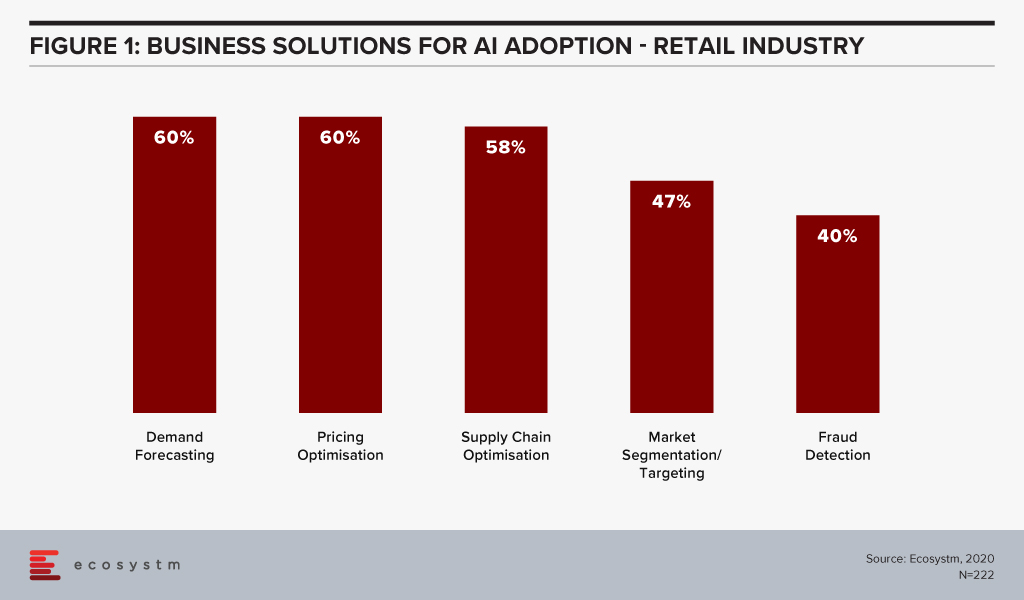
“In the New Normal, consumers are going to demand the same level of perfection that they have received and at the same cost. In order to make that possible, at the right time and at a lower cost, automation has to be implemented to improve the supply chain process, fulfill expectations and enhance visibility,” says Ghatak. “Providing differentiated CX is intimately dependent upon an aligned, flexible and efficient supply chain. Retailers will not only need to innovate at the store (physical or online) level and offer more innovative products – they will also need to have a high level of innovation in their supply chain processes.”
Digital Transformation in the Retail Industry
Ecosystm research reveals that only about 34% of global retailers had considered themselves to be digital-ready to face the challenges of the New Normal, before the pandemic. The vast majority of them admit that they still have a long way to go.
With COVID-19, the timeframes for digitalisation have imploded for most retailers. The study to evaluate the Digital Priorities in the New Normal reveals that in Asia Pacific nearly 83% of retailers have been forced to start, accelerate or refocus their Digital Transformation (DX) initiatives (Figure 2).
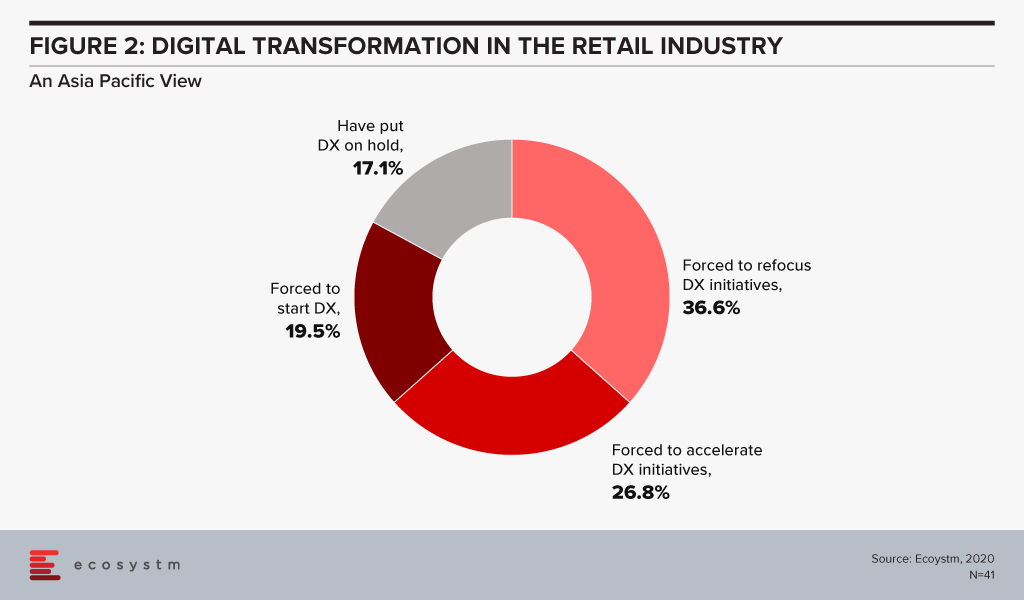
So, what technology areas will Retail see increased adoption oF?
Fairchild sees retailers adopt IoT, mobility, AI and solutions that deliver personalised experiences such as push notifications. What they are likely to do is blend different aspects of their physical and virtual environment to create a solution for customers. “To address in-store processing, hygiene, safety standards and compliance requirements, retailers will change their processes through a combination of resources, KPIs, automation, task management software and switching the information flow.”
Ghatak thinks automation has a significant role to play in improving both CX and the supply chain. “This is also an opportunity for retailers – both online and in-store – to create a solution experience where technologies such as Augment/Virtual Reality (AR/VR) can help. While retailers are adopting these technologies, with 5G rollouts, there is potential that the adoption will implode in a short time-frame.”
Those retailers that are not re-evaluating their business models and technology investments now will find themselves unprepared to handle the customer expectations when the global economy opens up.
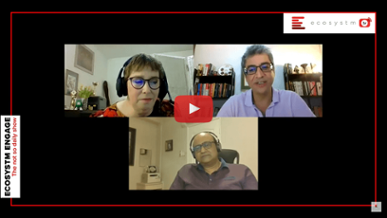
I was recently part of a virtual session with my fellow Ecosystm analysts, discussing what transformation will look like for various industries. One of the points that emerged is that the one industry that has had to transform itself completely, without having the luxury or time to think about it is Healthcare. Healthcare will emerge from this a transformed industry – in their rapid tech adoption; in their business processes and; in the mindset of the clinicians and administrative staff who’ve been at the frontline of this crisis. Will this be a revolution, or will the industry have to step back, once the immediate crisis is over?
Here are my thoughts on what is happening to the industry now and where we might be headed.
#1 Are we closer to our remote care dream?
I know I don’t sound very futuristic when I say that the biggest win from this crisis for the Healthcare industry will be the widespread adoption of telemedicine. We have heard the term bandied around for more than half a century now and over the years we have coined terms such as eHealth, digital health, mHealth and remote care, with the evolution of technology. Several healthcare providers in the Asia Pacific have implemented teleconsultation facilities to provide healthcare to remote, underserved regions and to out-of-country patients (especially those that actively seek to serve in the medical tourism space). Even for healthcare organisations that have the technology capabilities, it did not always make financial or regulatory sense to push for widespread adoption.
They have had to rush into it now, often throwing caution about cybersecurity and compliance to the winds. I am not saying that their hesitation will not return once this immediate crisis dies down – but what will happen is that governments will work with cybersecurity and legal experts to mandate it better. Once these guidelines are clearer, healthcare providers will be forced to create workflows and assign responsibilities. So, remote care where your healthcare provider will liaise with the data from your personal devices is not far off.
#2 Will we see a second wave of health and wellness apps?
With the rise of the use of smartphones, the last decade has seen a steady rise in healthcare apps. Most of these apps sync with health and wellness devices, but some use data from FDA-approved clinical devices, targeting chronic health conditions. This pandemic and the allied challenges of surviving in uncertain times, locked down in their homes, has also seen a rise of mental and emotional challenges. There will be a consumer uptake of these apps, as people realise that mental and emotional health can be as critical as physical illnesses. We will, therefore, see a proliferation of mental well-being apps.
Several organisations are having to deal with a remote workforce, with no clear visibility on how their employees are coping. It is not too far-fetched to imagine HR practices in some organisations, leveraging wellness apps – if not to monitor their employees’ mental state (that would be unethical), but – to engage with their remote employees and motivate them. These communications will largely be around the business, but some will use gamification to keep employees connected to the organisation’s visions and goals.
#3 Will healthcare providers realise the importance of evolving their supply chain management?
The healthcare industry, for all the cutting-edge research, that it represents has been remarkably slow to transform. The common perception of healthcare transformation is better clinical outcomes, genomics etc. But the reality is that most tech adoption in hospitals happens in Operations. The earliest impact of this crisis, when it was still confined to China was the disruption of the supply chain. Can you imagine how hard it must have been for the Healthcare industry to not be able to halt operations because of lack of resources? Premier healthcare institutions, mostly in the US, had realised the importance of better supply chain management long back – some implementing Lean and Six Sigma. Now healthcare organisations the world over – even in emerging economies – will adopt more technology in managing their supply chain.
However, what the COVID-19 crisis has exposed is the need for better collaboration and better visibility of external resources, to handle unprecedented scenarios. Countries that have done well to manage the crisis are those where the government took the vital step of encouraging and being the hub for cross-agency collaboration. Horror stories of US states outbidding each other for PPEs have emerged. On the other hand, we have had countries where governments have been able to guide healthcare providers on bed availability – across the public and private sector – so that affected patients could move seamlessly from one facility to another without any impact on the clinical outcome. Having a siloed view of your supply chain may not be sufficient in combating larger challenges – some healthcare organisations at least will opt for a more collaborative supply chain.
#4 Did super specialisation leave us underprepared?
Healthcare professionals have also been impacted in hugely different ways. On the one hand, we have nurses and doctors working 7-day shifts (without breaks), and healthcare systems looking to bring back retired clinicians to counter the shortage of healthcare staff. The Irish prime minister re-joined the healthcare workforce, making international headlines. On the other hand, we have several specialists who have practically no patient volume. Many of them are using teleconsultations to give basic healthcare advice and to guide patients on when to actually go into a hospital and when not. Several of these doctors actually want to help combat the COVID-19 crisis. But they will be the first to acknowledge that they are hesitant because they may have lost the skills needed to handle emergency situations.
While specialised knowledge in a particular disciple has helped improve clinical outcomes and often keep healthcare costs down – the rise of speciality hospitals in India is a good example – does it also leave doctors unprepared in times of crisis? Many doctors across the globe get subsidised education – partly funded by citizen taxes. Is it time for countries to look at a process where these doctors, irrespective of their specialisation, have to get re-trained in emergency services for a fixed period every year?
#5 What happens when the focus shifts to re-building other industries?
While the Healthcare industry has undoubtedly transformed, one must bear in mind that often transformation is a slower, steadier and more detailed journey. A transformation that rises out of disruption may not be successful in the longer term. Moreover, every healthcare provider organisation has had to evolve their processes almost in an isolated manner. Once the immediate crisis is over, the industry needs to take a pause (if they are able to) and take stock of the new practices and processes and evaluate what can continue and what has enormous associated risks.
But realistically, the Healthcare crisis is far from over. Once the threats from COVID-19 subside, healthcare providers will have to focus on elective procedures and other healthcare issues that are being put on hold now. People will visit hospitals more to consult about the health issues that they have been ignoring during these times. This will also coincide with when governments focus on re-building other industries – so Healthcare may not have access to emergency funds that they have now.
While we are all focused on handling the current crisis, now is also the time for healthcare policymakers to think ahead on how to sustain and evolve the Healthcare industry.
The FMCG industry has always been competitive given the need to drive high sales volume because of the low profit margins of the products. As the industry faces changes – such as the demographics of the consumer base and the need to introduce newer sales channels – technology is playing an important role in ensuring that the organisations can remain competitive.
eCommerce Disrupting the FMCG Industry
The concept of online retail is said to have originated in some form in the 1960s. But with the growth of the access to the Internet in the 1990s and Amazon’s competitive business model, it has disrupted the retail and FMCG industries. As we see a steady growth in smartphone usage, digital payments, online banking and app-based platforms, online retail is becoming mainstream. While initially thought to be ideal for the purchase of durables and entertainment products and services (where price comparison is key), it has become common for FMCG companies to use eCommerce platforms. Even perishables are being purchased online with the rise in the number of online grocery stores. This is impacting the FMCG industry in a number of ways:
Change in Marketing Strategy
FMCG companies need to continue their traditional marketing strategy for in-store consumers. But at the same time, they need to reach out to a wider base of consumers who shop online. The profile of these consumers is different – younger and technologically savvier. They do not necessarily believe in brand loyalty. While the browse-to-buy ratio for FMCG products is high, they are having to invest in digital marketing strategies including personalised campaigns and presence in social media and online forums. Even packaging for in-store and online products need to be different for some products.
Increased Competition
An online presence means that your brand can reach a wider audience – this also means that the competition becomes tougher. Now global brands compete with brands from other countries as well as local brands on the same online platform. This raises the bar, with companies competing not only on price and product but also on delivery services and better customer feedback.
Increased Complexity of the Supply Chain
No longer can an FMCG company depend solely on trucks delivering their products to stores at a fixed time of day. As they play increasingly in the B2C space, they have to constantly be aware of seasonality and spikes. This means that their supply chain operations become that much more complicated, and they are having to spend more on logistics and transportation. There is also the need to handle a larger volume of data.
Changing Consumer Profile
As mentioned earlier, the consumer profile of the FMCG industry has changed to include younger consumers who want to shop online. It also includes consumers in newer markets made possible by eCommerce platforms. FMCG companies also have to cater to consumers who are conscious about product quality, the environment and ethics. This means they want to know where the products were grown or manufactured, their carbon footprints and generally want more traceability of the products they are purchasing. This has led governments to come up with guidelines to protect consumer rights. Recently, the UK government issued guidelines on the quality, labelling, standards and food safety including the right logos, health and identification marks.
The global Ecosystm AI study reveals the top priorities for FMCG companies, focused on adopting emerging technologies (Figure 1). It is clear that their key priority is to handle the competitive market by focusing both on the consumer and the supply chain. Supply chain optimisation through demand forecasting ensures that they are not managing extra stock, and simultaneously not losing out on customers because of lack of stock. This just-in-time inventory management includes initiatives such as pricing optimisation in response to market demand, competition and – especially in the case of perishables – ensuring that stock closer to the use by date is cleared.
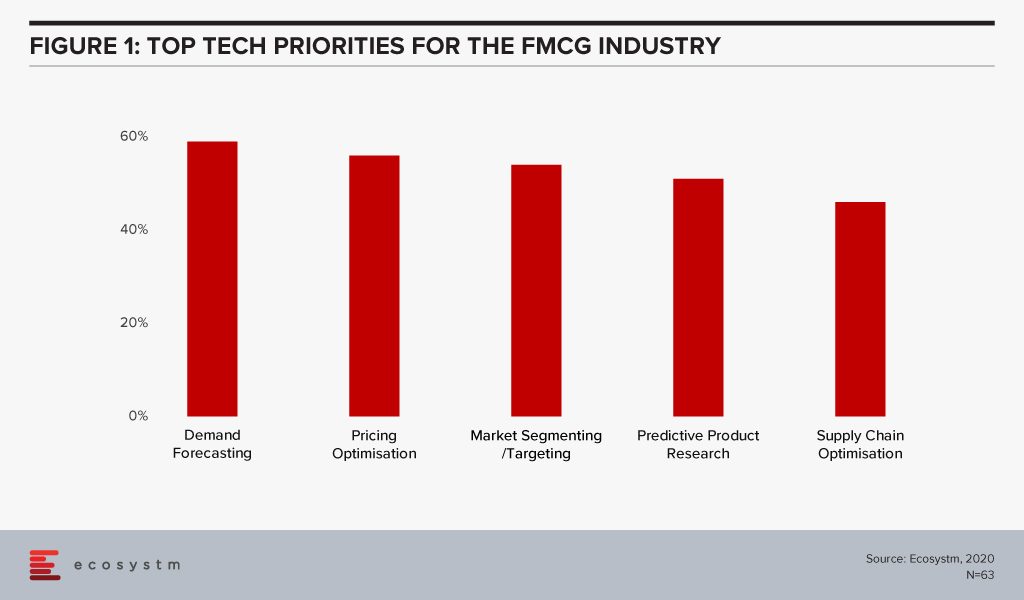
Technology as an Enabler of FMCG Transformation
The one advantage that FMCG companies have today is they have access to enormous customer and inventory data. As a result, they are able to leverage several emerging technologies to transform.
Digital Marketing
One area that is transforming the industry is digital marketing which includes multiple aspects such as search engine marketing, video marketing, social media activity and email marketing. While several technologies come together for a digital marketing solution and AI is a key component of the solutions, there are platforms that provide an end-to-end solution.
Digital marketing is most effective with a targeted group of customers and when organisations can identify digital or social champions. Johnson & Johnson’s Babycenter.com is a good example of how creating a digital community can help market products. The core idea behind the website is to give expecting and new mothers advice on early childhood. While on the surface it appears disassociated from Johnson & Johnson, the site almost exclusively carries their advertisements. This gives them a targeted base to push their products to. Dollar Shave Club is another example of how brands can leverage digital marketing. Their social media engagement has been so successful that they got bought over by Unilever. The digital campaign includes incentivising members with their products for posting about them on Instagram or Facebook.
Blockchain
FMCG companies are investing in Blockchain and digital ledger technologies for track and trace functionalities and operational efficiency. The technology not only helps manage the supply chain better by effective shipping timelines maintenance, delivery management and inventory management; it also helps build trust in a brand. It helps in compliance management, reduces the number or need for middlemen, easier handling of cross-border transactions and brings about an end-to-end accountability.
Danone initiated a Track & Connect service for their baby formula using Blockchain for transparency and traceability to show the authenticity of their products to parents and for a better customer experience. FMCG companies will benefit immensely from the farm-to-fork accountability concept initiated by Agriculture.
AI
From predictive analysis to machine learning to deep learning, AI is bringing a lot of benefits to FMCG companies. AI is enabling companies to discover gaps (both in their consumer interactions and in the supply chain) and make their processes intelligent – including demand forecasting, supply chain optimisation, personalised product offerings, social media analytics, consumer sentiment analytics and recommendation engines.
FMCG organisations are analysing internal and external data sources for both sales and improved customer experience. As FMCGs are forced to sell online to remain competitive, they have access to a high volume of the consumer as well as supply chain and inventory management data. Coca-Cola remains one of the leaders in the FMCG market by leveraging this data, including product research and social data mining. Even their vending machines are looking to leverage AI for personalised offerings and for loyalty programs.
The need to enhance the customer experience has also seen innovations like the Maggi Chatbot – “Kim”- that helps customers learn about Maggi recipes, ingredients, and dietary requirements, through Facebook Messenger.
FMCG companies that cannot afford to invest in technologies such as AI also have the option of leveraging the technology offerings of their online retail platform. eBay offers analytics as a service to the sellers – offering them data, metrics, and analytics to help them succeed. They also introduced computer vision technology to help sellers create clearer and more attractive images for the platform.
In this competitive market, we will see FMCG companies – and not just the big global brands but also the local producers – embrace more technology.

2020 was originally forecast as a good year for technology spend. Many categories took a hit in 2019 – hardware, telecommunications, datacentres – even the software and IT services segments came down from their high growth rates of previous years. The consensus for growth in IT spend in 2020 was somewhere between 3-4%. But that growth is now under threat by the COVID-19 virus that is spreading across the globe. The 26th February was a significant day, as the number of new infections outside of China is now greater than those in China. Furthermore, the growth in infections is not isolated. Iran, Italy and South Korea all have experienced significant growth and the virus has hit Brazil, directly from Italy.
With the situation changing every day it is hard to have a firm view on how it will impact broader economic growth as well as the technology spending. Much will depend on the ability of countries to control the spread of the virus along with the fiscal stimulus packages of governments across the globe. Some countries are in a better position than others to push money into economies to keep them growing.
But even with the uncertainty, it is worth noting some feedback we are getting from tech buyers, vendors and economists. While much of this feedback is anecdotal, we believe it is indicative of trends across the market. The next few weeks are critical. If China shows that they can stop the transmission of the virus, that will help global confidence which has been hurt by the newer outbreaks in Italy, Iran and Korea.
Overall Economic Spend is Slowing
Businesses across the globe – particularly those in heavily impacted economies (such as China, Italy, Japan & South Korea) and those impacted by the slowdown in China (Thailand, Australia etc) – are putting the brakes on spending across the board. And there are not too many initiatives in businesses today that don’t involve technology. We are seeing projects delayed and – more rarely – cancelled. Several central banks, such as those in Thailand and Singapore, have lowered their growth forecasts, as has the IMF and OECD. Ratings agencies and economists have also reduced their growth forecasts for heavily impacted economies. The USA is avoiding much of the slowdown although the Nasdaq High Tech Index was down around 8-9% on the 28th February – the market has priced potential future slowdown into share prices already.
Limited Face-to-Face Collaboration Will Slow Tech Spending
We are also seeing the projects that are underway slowing down: more staff are required to work from home; experts can’t fly in to help drive projects; and without teams meeting physically, collaboration has become harder than ever before.
This doesn’t mean the projects aren’t happening – the timelines are slipping. Will this impact the overall spending in 2020? Yes! But not by much at all, as many projects these days are delivered in 3-6 months – not 24 months like years gone by. So, delivery will mostly happen in 2020, but more in the second half than the first half. But again, with the situation changing every day, the scenario might change. As soon as growth in the number of infections slows down and the travel bans are lifted, we can expect activity to slowly return. But the further out that is, the more projects will decrease scope, be cancelled or be shelved for another day.
Another factor impacting innovation and the resulting technology projects is the lack of face-to-face collaboration between management teams. Some businesses have already put into place initiatives to ensure their board and executive management do not meet face-to-face. This is because they are considered the most valuable assets to the business – and are often likely to be in the age group most heavily impacted by the coronavirus (over 50). While not suggesting that collaboration cannot happen in virtual environments, it is sometimes a shared experience or non-business interaction that might drive a new idea for the business. And that idea might end up driving tens of millions of dollars of technology spending.
Cash Flow is Impacted – Which Slows Business Investment
Cash flow is already being impacted. Small and medium enterprises (SMEs) are already feeling the pinch, and they don’t have access to the funding tools that many large businesses use to get through tough times. SMEs really represent the biggest threat to spending: if a large business has to lay off some staff, they can then get a project going as soon as the economy or their sector recovers and employ the people they need, as required. But in countries like Australia and the US, small businesses represent almost 40-50% of economic activity. If SMEs shut down or even restrict spending, it takes some time for new businesses to start up and fill in the gap they leave. SMEs don’t tend to buy software or services from the large vendors – they tend to use small and medium services and software providers – so it is these smaller technology businesses that are immediately threatened if the coronavirus spread continues. The multiplier effect quickly comes into play here to reduce consumption, employment and economic activity.
We are also aware that some businesses that are directly impacted by the virus (such as those in the travel sector) have informed their suppliers that they won’t be paying any bills until mid-year. This could also put a small technology provider under – whereas a larger one should be able to survive the cash-flow crisis. Despite most economies having a low interest rate environment, the access to capital is not easy, particularly given the risk to the overall economy. A further challenge to global expenditure and an accelerated recovery is the US elections which provide distraction to businesses in the US and globally.
Cancellation of Customer Events Will Limit Technology-Led Innovation
Many vendors have cancelled or postponed their customer events, even in relatively unaffected markets such as Australia. And nearly every vendor will attest to the spike in opportunities and deals that get signed after these events. The coming together of potential and existing customers with thought leaders, tech evangelists, bleeding edge customers and the partner ecosystem drives new ideas. Individuals get inspired to act – they hear about best and next practice and kick off conversations within their businesses. They see how technologies can impact other businesses and use those assumptions within their own business cases. Sceptical customers become converts, and those already considering projects sometimes accelerate them.
With these events cancelled tech spending will not collapse. Companies still have budgets and these budgets will be, for the most part, spent. But it is the innovative initiatives that will suffer – the exploration of new technologies or services, the experimentation and testing that won’t happen because people simply won’t know about it. This is the spending that is typically not budgeted for – the new spend that often has a big impact on business results and customer outcomes. These customer events are learning opportunities – without the events the learning will be harder and slower to push out. So, this will likely have more of an impact on spending in calendar Q2-Q4. But without other assets in the market or other chances to educate clients and prospects, this spend simply won’t happen.
The COVID-19 virus is also impacting the technology supply chain. Many technology products are manufactured in China – or rely on components manufactured in China. Factories across China have been shut down – and while some are coming back online, it is hard to know how long it will take them to get back to full capacity. Transport services in China are impacted –globally 200,000 flights have been cancelled since the public emergence of the coronavirus. Some products are waiting but just cannot be shipped. A number of vendors have flagged the impact of the slowdown to the supply chain on their revenues, including Apple and Microsoft. With limited supply, prices are rising, which slows down demand. While this may show some short-term opportunity for the cloud providers, the hardware companies and the software providers that rely on the availability of hardware will feel the impact. In the longer term, it may lead to business reviewing their supply chain and risk analysis. This presents an opportunity for India, Vietnam and other potential manufacturing hubs.
The Overall Impact of the COVID-19 Will be Real and Measurable
Ultimately, we believe that the coronavirus will wipe up to 1.5% off the total tech spending for 2020 – bringing the overall average down to between 1.5% and 2.5%. Part of this is based on the fact that technology spending is coming off a poor year. Confidence was just starting to climb with some of the hardest hit segments expected to return to growth in 2020. This confidence will disappear – and could lead to further price competition. Which is good for the buyer but bad for the whole vendor supply chain!
But again, this depends on the response of central banks and the ability of countries to control the spread of the virus. The development of a vaccine would be ideal but appears to be highly unlikely. The sooner it is brought under control – along with effective targeting of fiscal stimulus packages – the lower the impact on overall economies and the technology spending of businesses.
Some sectors will witness growth – telecoms providers, collaboration software and tool providers, remote and online education providers, cloud providers and healthtech will all witness growth – in fact many are already! Digital spending will increase as face-to-face opportunities plummet – this will drive opportunities for advertisers, digital agencies and developers.
Now is the time to make contingencies – vendors need to get better at digital marketing and selling and simpler implementation. Tech buyers and implementers need to put in place best practices for remote working – many companies witness an increase in productivity when they get remote working right.
Please let us know your feedback or thoughts in the comments section – we look forward to keeping the analysis going – and stay healthy!
This post was authored by Tim Sheedy, with valuable assistance from Phil Hassey, Sash Mukherjee and Claus Mortensen.

It can often be difficult to keep track of assets and transactions in a business, and that is where Blockchain is unleashing its potential. It is revolutionising enterprises with its shared ledger technology. There are numerous, and specialised, use cases of Blockchain but the adoption is nascent in most industries. There are a few early adoption use cases of Blockchain, however, which have the potential to replace traditional systems and processes.
In the global Ecosystm Mobility study, organisations are asked about the adoption of Blockchain as a means of authentication. Industries that appear most open to Blockchain adoption are those that have also embraced IoT for tracking and traceability.
Adoption of Blockchain for Authentication – An Industry Comparison
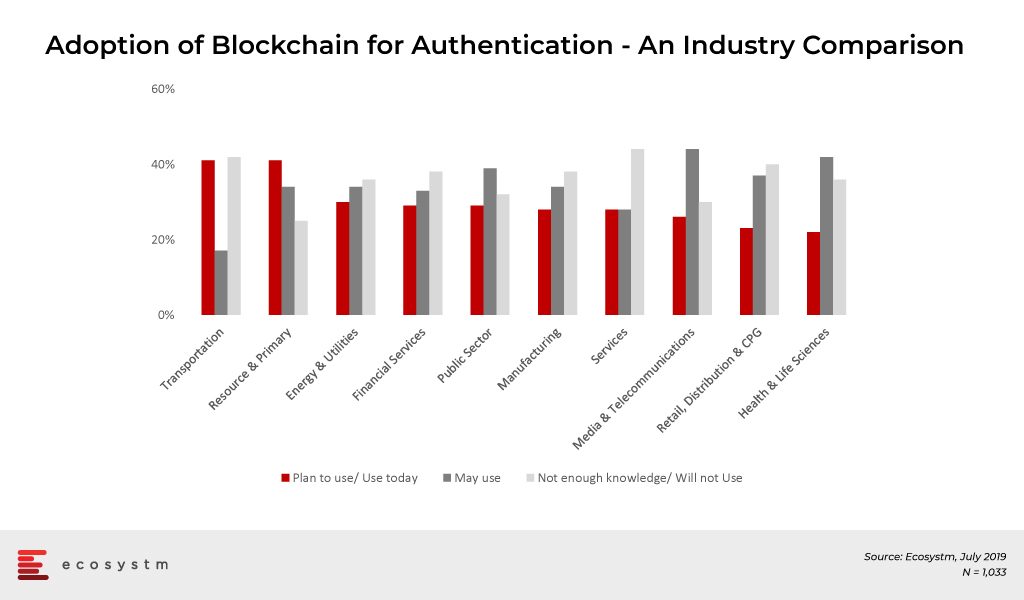
Across industries Blockchain technology is being used primarily for these use cases:
Supply Chain Traceability
Supply chain traceability allows producers, retailers, and consumers to track products from source to consumer. It connects all points in the supply chain, creating transparency and trust in the product. When a business comprises complex processes, a large and dispersed workforce, multiple locations and different operations, a lot of administrative and regulatory frameworks are required to manage and control the supply chain. Functions such as order management, procurement, import, delivery, tracking, and invoicing have their own unique set of requirements and processes. In several cases, especially across primary and retail industries, business complexity has been reduced with the use of Blockchain. The technology allows for improving digital assets and inventory tracking for better services and processes.
Blockchain is ensuring food safety by providing a complete view of the supply chain and creating a real-time trail of products – allowing a ‘farm to fork’ view. Walmart is a good example of how retailers can use Blockchain technology to ensure that they sell fresh produce. Fresh produce shipments can be tracked as they change hands from the farmers to the middlemen, to the distributor and finally to the store. This can have an enormous impact on containing food-borne diseases and food contamination. Not only does Blockchain increase food safety, it ensures fresher food since it secures production and packing dates.
Intellectual Property Intermediary (IPI), an organisation established under Singapore’s Ministry of Trade and Industry, is an affiliate of Enterprise Singapore and focuses on technology innovations in the industry that can empower enterprises to develop new processes, products, and services. IPI has identified Blockchain Technology for Food as an area where the industry can benefit from innovation. The ecosystem will also benefit from the information gathered, with the potential to further improve the production chain.
Fraud Prevention
Taking supply chain visibility a step further, Blockchain technology is being used for fraud prevention – especially payment fraud. Financial transactions are complex and involve multi-step processes and human intervention – involving collaterals, settlement, currency denominations, third-party mediation, and so on. It is often the prime target for fraudsters. The most common instances of fraud involve bank to bank transactions, mobile payments, and digital identity fraud, essentially by tampering with ID or using it an unsanctioned way – providing unauthorised access to digital systems and falsifying information.
Blockchain helps automate preventive measures enabling real-time information sharing which is transmitted on a chain of connected devices where all the nodes in a system verify the transaction. Since it stores the data on several nodes and every other user on the network has a copy of the entire data on the Blockchain, it is virtually impossible to hack or destroy it completely.
Earlier this year, Standard Chartered Singapore showcased their cross-border trade finance transaction which digitalises trade processes and financing documentation. Blockchain enabled the transaction between parties by digitally streamlining the documentation process while providing security and transparency between the partners. Not only does it support the clients’ entire supply chain, but it also creates a transparent way to provide same-day trade financing.
Non-profit organisation BitGive Foundation uses Blockchain technology to provide greater visibility to their donors into the receipt of funds and how they are used by sharing financial information and project results in real-time. The GiveTrack project is built on Bitcoin and Blockchain and is a user-friendly, data-centered and comprehensive user interface. People making donations can precisely track the donations and how the funds were used.
Legal & Compliance
In industries that have higher Compliance & Regulatory requirements, Blockchain can enable safe, secure, and scalable data-sharing. The industry is seeing instances of self-executing contracts, smart registries, secure and time-stamped documents with Blockchain. Blockchain is introducing abilities to record events for a long duration which might include indisputable claims, criminal records, case procedures to support the potential legal work.
Dubai launched a city wide blockchain strategy. Dubai Land Department is implementing blockchain to make property transactions secure, transparent and immutable, thereby reducing fraud and eliminating reams of physical documents. This impacts the entire ecosystem – customers, developers, the land department, utility providers, payment channels, and municipalities – to work in collaboration.
Shipping companies that need to enforce global contracts daily are also benefitting from Blockchain. However, the biggest use cases will eventually come from the Public Sector – across citizen services and criminal justice systems. For instance, National Stock Exchange of India (NSE) is testing Blockchain e-voting facilities. The project is still at the pilot stage and aims to tokenised voting which makes it easy to conduct test and audit for the votes. This allows the regulating authorities to access real-time data, and at the same time, provides means to audit the regulators.
Cybersecurity
73% of global organisations believe that a data breach is inevitable, according to the Ecosystem Cybersecurity Study, and only 18% of them use some form of tokenisation and other cryptographic tools. Blockchain technology offers several capabilities in mitigating cybersecurity risks and detecting and combating cyber attacks. For example, Blockchain can be used to prevent DDoS attacks, and crypto secured biometric keys can replace passwords providing robust ID authentication systems, more secure DNS and decentralised storage. Blockchain implementation can also prevent man-in-the-middle (MITM) attacks by encrypting the data in transit so it is not manipulated during the transmission or accessed by unauthorised parties – thus maintaining data integrity and confidentiality.
Lockheed Martin, a US security company, is implementing Blockchain into their protocol. The company is enhancing Blockchain cybersecurity protocol measures in engineering systems, supply chain risk management, and software development. This includes researching on expanding on Blockchain capabilities protect their weapons development unit and make it incorruptible.
eGovernment initiatives will also benefit from Blockchain. The biggest stumbling block for providing eservices has always been cybersecurity, where the Government cannot be sure that the citizens are able to access their own records in a secure manner. It has always been a question of responsibility and liability – is the Government liable for a data breach that happens because of a citizen’s fault? Estonia is using Blockchain to protect their digital services such as electronic health records, legal records, police records, banking information, covering data and devices from attacks, misuse, and corruption.
Customer Experience
The ultimate benefit of Blockchain will be realised when it is used to enhance Customer Experience (CX). It brings transparency in doing business, gives on-demand data visibility and fosters trust in customers. A company that shows all transactions between the company and the customer, and in a secure manner, can create a better relationship, increase overall customer satisfaction and retain their customers in a competitive market. For example, Blockchain technology can allow more secure and transparent loyalty programmes, through token creation that can be redeemed on-demand, without customer service intervention. Singapore Airlines’ KrisFlyer structures their payments and loyalty programme with Blockchain. Their digital wallet enables members to convert KrisFlyer miles into KrisPay miles instantly to pay for their purchases at partner merchants. The users can pay through an application by scanning a QR code at a merchant’s location .
Customers will increasingly look for ease of use and security in their transactions. Bank of America has filed a patent for Blockchain powered ATM, for securing records and authenticating business and personal data. This will boost the transaction rate and facilitate various transaction experience with full encryption and security. Blockchain-enabled transactions can be registered and completed with greater easy while lowering the transaction costs for customers and keeping the network safe.
While Blockchain technology is continuing to evolve for a range of applications and industries, it comes with its own share of risks. Adoption should not be based on the hype around the technology but should be evaluated carefully. The starting point should obviously be a real business needs analysis.
Speak with an expert today to evaluate whether your organisation can benefit from Blockchain.


